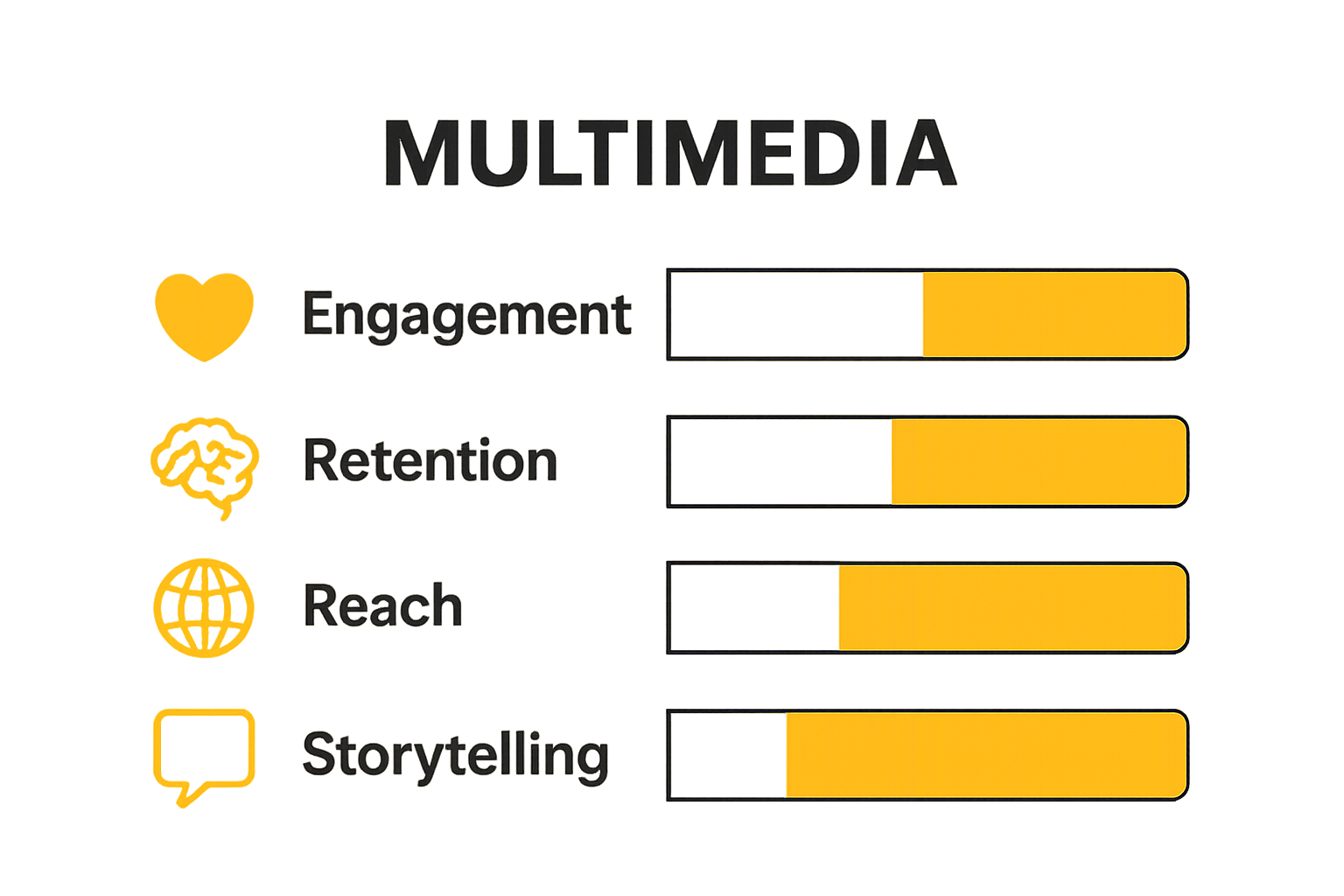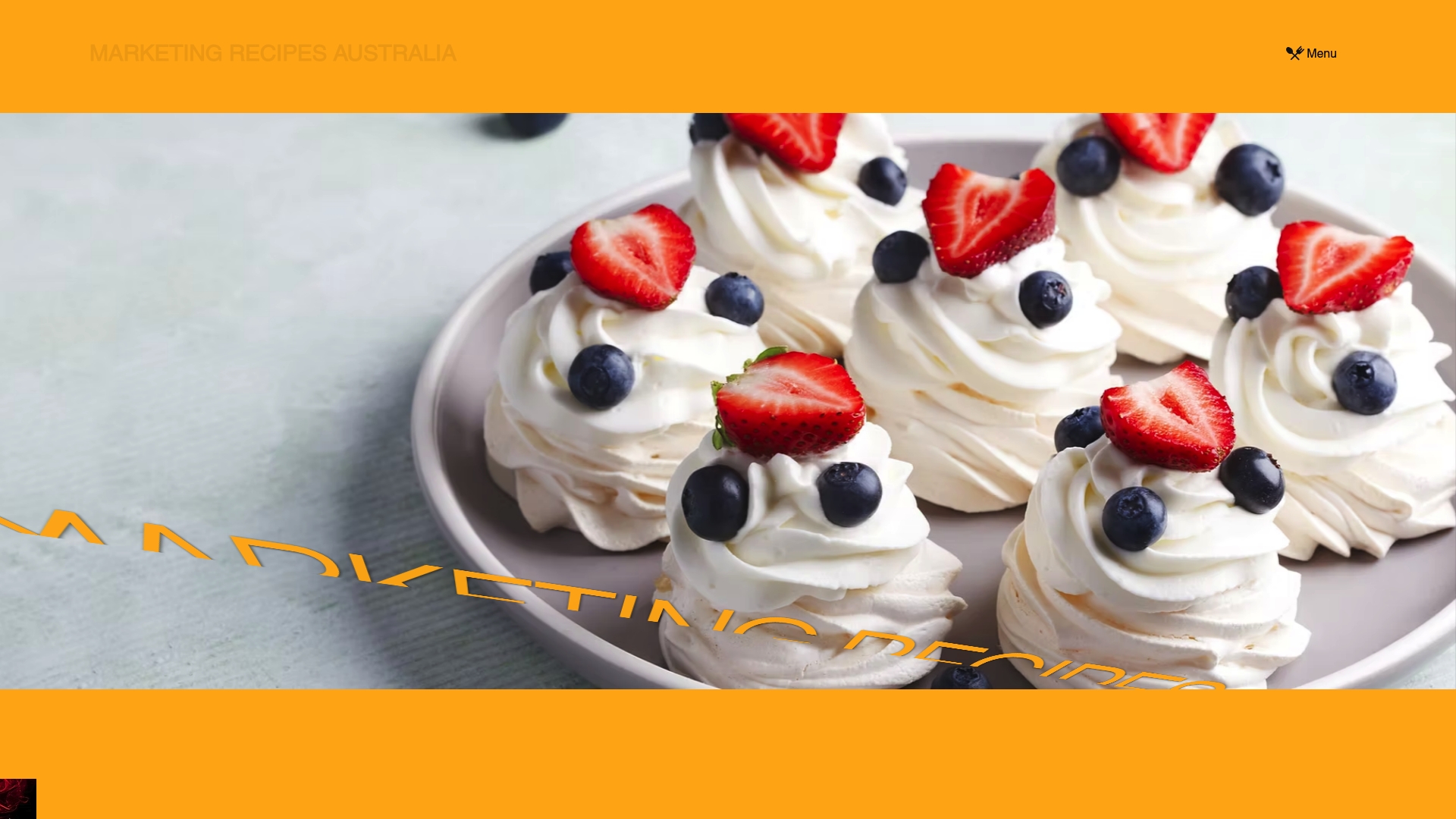What is Multimedia Marketing? Understanding Its Power
- Eddie The Chef

- Sep 20
- 7 min read

Multimedia marketing is everywhere and it is quickly changing how Aussie businesses connect with you online. Most companies still focus on just one or two ways to share their stories but now, more are mixing video, audio, graphics, and text all at once. Get this. People are twice as likely to remember a message when it is delivered through multiple media formats compared to just one. The wild part is these layered campaigns go beyond flashy visuals—they actually help businesses build deeper trust and loyalty with their audience, something single-channel ads can never match.
Table of Contents
Quick Summary
Takeaway | Explanation |
Multimedia marketing enhances audience engagement. | Combining various media formats captures attention and caters to different audience preferences effectively. |
Diverse content formats improve information retention. | Visuals and interactivity make messages more memorable, leading to better information recall. |
Understanding target demographics is essential. | Tailoring content to specific audience needs increases the effectiveness of multimedia marketing strategies. |
Interactive elements foster deeper connections. | Engaging audiences through participatory experiences transforms brand interactions into collaborative journeys. |
Measuring performance is crucial for success. | Tracking engagement and conversion metrics helps assess the effectiveness of multimedia marketing efforts. |
Defining Multimedia Marketing: Key Components
Multimedia marketing represents a strategic approach where businesses leverage multiple media formats to communicate their brand message and engage audiences. Unlike traditional single-channel marketing, this method combines various digital and visual communication techniques to create comprehensive, immersive experiences.
Below is a table summarising the key components of multimedia marketing and their specific roles as outlined in the article.
Component | Description |
Text | Written content providing context and detailed information |
Visual Graphics | Infographics, illustrations, and design elements enhancing visual appeal |
Video | Moving imagery used to demonstrate products or share brand stories |
Audio | Podcasts, music, voiceovers fostering emotional connection |
Interactive Elements | Animations, clickable graphics, and online experiences driving participation |
Understanding Multimedia Integration
At its core, multimedia marketing blends different content types to deliver a cohesive narrative. The University of Adelaide’s research highlights how digital technologies transform communication strategies by integrating diverse media elements.
Key multimedia components include:
Text: Written content providing context and detailed information
Visual Graphics: Infographics, illustrations, and design elements
Video: Engaging moving imagery demonstrating products or telling brand stories
Audio: Podcasts, music, voiceovers creating emotional connections
Interactive Elements: Animations, clickable graphics, online experiences
Strategic Content Deployment
Successful multimedia marketing requires thoughtful planning and seamless integration. Businesses must understand their target audience and select media formats that resonate most effectively. This means crafting content that speaks directly to customer preferences, whether through short-form videos, compelling graphics, or interactive web experiences.
The goal is creating a unified brand narrative across multiple platforms, ensuring consistent messaging while maximizing engagement through varied communication channels. By diversifying content delivery, businesses can capture audience attention more dynamically and memorably than traditional single-format marketing approaches.
The Importance of Multimedia Marketing for Businesses
Multimedia marketing has emerged as a powerful strategy for businesses seeking to connect meaningfully with their target audiences in an increasingly digital world. By combining various communication channels and content formats, organisations can create more engaging, memorable, and impactful marketing experiences.
This table compares the main advantages of multimedia marketing with traditional single-format marketing to illustrate why businesses benefit from a multi-channel approach.
Aspect | Multimedia Marketing | Traditional Single-Format Marketing |
Engagement | High, appeals to varied preferences and senses | Limited, appeals mainly to one preference |
Information Retention | Improved through visual, audio, and interactive mix | Lower, often reliant on text or basic visuals |
Audience Reach | Broader, spans multiple channels | Narrow, limited to chosen channel |
Brand Storytelling Depth | Deep, enables layered, multi-format narratives | Shallow, stories often constrained by format |
Emotional Connection | Strong, driven by diverse content types | Weaker, fewer opportunities for personal resonance |
Breaking Through Digital Noise
According to Alphacrucis University College’s Marketing Communication research, modern consumers are bombarded with information across multiple platforms. Multimedia marketing provides businesses with a strategic approach to cut through this digital clutter and capture audience attention.
Key advantages of multimedia marketing include:

Enhanced Engagement: Multiple content formats appeal to different learning and perception styles
Improved Information Retention: Visual and interactive content helps audiences remember messages
Broader Audience Reach: Different media channels attract diverse demographic segments
Increased Brand Storytelling Opportunities: Rich, multi-format content enables deeper narrative exploration
Strategic Communication Effectiveness
Multimedia marketing transcends traditional communication limitations by offering businesses flexible, dynamic ways to present their brand message. By understanding consumer behaviour and preferences, organisations can craft tailored experiences that resonate on emotional and intellectual levels.
The strategic deployment of multimedia content allows businesses to:
Create more authentic connections with target audiences
Demonstrate product value through varied presentation methods
Build brand personality across different communication platforms
Adapt messaging to suit specific audience segments
Ultimately, multimedia marketing represents a sophisticated approach to modern business communication, enabling organisations to tell their stories more compellingly and effectively than ever before.
How Multimedia Marketing Engages Audiences
Multimedia marketing transforms audience interaction by creating immersive, multi-sensory experiences that capture attention and foster deeper connections between brands and consumers. By strategically combining different media formats, businesses can develop more nuanced, compelling communication strategies.
Psychological Engagement Mechanisms
Research from Griffith University’s Communication Studies department reveals that human brains process visual and auditory information differently, making multimedia approaches inherently more engaging than single-format communications. This neurological response enables businesses to communicate more effectively by appealing to multiple sensory channels.
Key psychological engagement strategies include:
Emotional Resonance: Using storytelling techniques that trigger empathetic responses
Cognitive Stimulation: Presenting information through varied content formats
Attention Retention: Creating dynamic, interactive experiences
Personalization: Tailoring content to specific audience segments
Building Interactive Brand Experiences
Multimedia marketing moves beyond passive consumption, inviting audiences to become active participants in brand narratives. This approach transforms traditional one-way communication into a collaborative, immersive journey.
Effective engagement techniques involve:
Creating interactive video content
Developing gamified marketing experiences
Integrating user-generated content
Designing seamless cross-platform experiences
By understanding audience preferences and leveraging diverse media formats, businesses can craft marketing strategies that not only inform but genuinely connect with their target demographic. The goal is to create memorable, meaningful interactions that transcend traditional advertising approaches.
Exploring the Various Formats of Multimedia Marketing
Multimedia marketing encompasses a diverse range of digital communication formats, each offering unique opportunities for businesses to connect with their audiences. Understanding these formats enables organisations to craft more targeted, engaging marketing strategies that resonate across different platforms and consumer preferences.
Digital Content Diversity
Victoria University’s research on communication strategy highlights the importance of integrating various media formats to create comprehensive marketing approaches. Modern multimedia marketing spans multiple digital and traditional channels, providing businesses with flexible communication tools.
Primary multimedia marketing formats include:
Video Content: Short form videos, explainer videos, testimonials, live streams
Audio Platforms: Podcasts, music integrations, voice-based advertisements
Interactive Digital Media: Webinars, online workshops, virtual product demonstrations
Visual Graphics: Infographics, animated presentations, digital illustrations
Social Media Content: Carousel posts, stories, reels, interactive polls
Strategic Format Selection
Selecting appropriate multimedia formats requires understanding audience demographics, technological preferences, and communication objectives. Businesses must consider factors such as:
Target audience age and digital literacy
Platform accessibility and user engagement
Content complexity and communication goals
Production resources and technical capabilities
Successful multimedia marketing involves creating a cohesive narrative across different formats, ensuring consistent messaging while leveraging the unique strengths of each communication channel. By thoughtfully combining various media types, businesses can develop rich, immersive marketing experiences that capture audience attention and drive meaningful engagement.
Connecting Multimedia Marketing to Business Success
Multimedia marketing serves as a critical strategic tool that transforms how businesses communicate, engage, and ultimately drive growth in an increasingly digital marketplace. By leveraging diverse communication channels, organisations can create more meaningful connections with their target audiences and achieve significant competitive advantages.
Measuring Marketing Performance
Central Queensland University’s research on Online Marketing Strategies emphasises the importance of understanding digital technologies’ transformative impact on marketing effectiveness. Businesses can track multimedia marketing success through comprehensive performance metrics that go beyond traditional measurement approaches.
Key performance indicators for multimedia marketing include:
Engagement Rates: Measuring audience interaction across different platforms
Conversion Metrics: Tracking how multimedia content translates into tangible business outcomes
Brand Awareness: Assessing increases in brand recognition and recall
Customer Retention: Evaluating long-term audience loyalty and repeat interactions
Strategic Business Outcomes
Multimedia marketing delivers substantial business benefits by creating more dynamic, responsive communication strategies. These approaches enable organisations to:
Build stronger emotional connections with customers
Differentiate themselves in competitive markets
Communicate complex messages more effectively
Adapt quickly to changing consumer preferences
By integrating multimedia marketing strategies, businesses can transform their communication from transactional interactions to meaningful dialogue, fostering deeper customer relationships and driving sustainable growth. The ability to tell compelling stories across multiple platforms becomes a powerful competitive advantage in today’s rapidly evolving digital landscape.

Ready to Power Up Your Business with Multimedia Marketing?
Feeling overwhelmed by all the digital noise and struggling to get your business message across? As the article points out, today’s regional businesses face the real challenge of standing out and making meaningful connections in a crowded marketplace. If you want to break through with text, video, visuals, and interactive content, you need more than just a good idea. You need a multimedia marketing partner who understands the importance of unified brand storytelling and dynamic audience engagement.

At Marketing Recipes Australia, we bring decades of expertise and a hands-on, kitchen-inspired approach to your marketing mix. From traditional video production and content creation to social media, web design, and email campaigns, we custom-build solutions that tackle your business pain points head-on. Let us help you create a brand experience your local customers will remember. Discover your next winning strategy by visiting Marketing Recipes Australia now and see how our tailored multimedia marketing can help your business stand out today.
Frequently Asked Questions
What is multimedia marketing?
Multimedia marketing is a strategic approach that combines various media formats, such as text, video, audio, and visual graphics, to create comprehensive and engaging brand communications.
How does multimedia marketing enhance audience engagement?
By integrating different content formats, multimedia marketing appeals to diverse learning styles and sensory experiences, making it more effective in capturing attention and fostering emotional connections with audiences.
What are the key components of multimedia marketing?
The key components include text for context, visual graphics for aesthetic appeal, engaging videos, audio for emotional connection, and interactive elements for audience participation.
Why is multimedia marketing important for businesses today?
In an increasingly digital world, multimedia marketing helps businesses cut through digital noise, creating memorable experiences that enhance brand storytelling, improve information retention, and reach a wider audience effectively.
Recommended
Comments